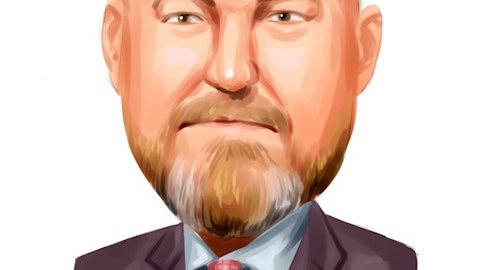Ryan Sigdahl : Great. Thanks for that.
Operator: One moment for our next question. Our next question comes from Greg Gibas with Northland Securities. Your line is open.
Greg Gibas: Hey, good morning, Jonathan, Aaron. How are you doing?
Jonathan Shepko: Good morning, Greg.
Aaron Coley: Good morning.
Scott Hoppe: Hey, Greg, how are you?
Greg Gibas: I’m good. Thanks. Hey. I wonder if you could discuss the assumptions that go into the updated outlook. Is that just maybe the assumption that rates remain stable kind of like we’ve seen in the most recent quarter?
Jonathan Shepko: Yes. I mean, I think if you look at it, so last quarter, we took guide down to — I’ll just use the lower point of the guide, $200 million so $200 million to $210 million. So $200 million, we had, as we talked about this quarter, between a softer equipment market, we had about a $2.5 million headwind there. And then we had about $5 million given the diesel volatility. So those were both things that we hadn’t kind of factored in when we provided that $200 million to $210 million guide. So you got $7.5 million of headwind there. Used truck market is not going to improve. So we don’t think in Q4, we’re going to see any kind of gain on sale. So you kind of approximate the same headwind kind of $2.5 million, so you’re kind of going, okay, well, $200 million feels like $190 million, right?
You take off that kind of $10 million in kind of totality so $2.5 million and $2.5 million from the equipment market, $5 million from fuel and so it kind of feels like that’s direction where we’re going. And as we think about the last two months of the year, we think that the rates are going to fall with normal seasonality that we experienced at this time of the year. For us, the big question and why there’s that little bit of tweaking between $185 million and $190 million versus the kind of quick bridge, I just gave you from $190 million to $200 million. It’s really, I think, about how productive the LP and the owner operators are those last couple of months. And do they shop for work. They’re independent contractors as you appreciate. And so it’s okay, do they take the rest of the year off?
Do they come and say, look, I haven’t hit my target income for the year, so I’m going to work hard, work through the holidays and get it done or we’re just going to say, hey, look, it’s been a tough year, we’ll start over next year. So I think that’s the little bit of the hedge that we have in there with that $185 million to $190 million.
Greg Gibas: Great. Extremely helpful. And then, I wanted to just follow-up on the integration process of the OpCos. Where do we stand with that? Do you expect to see continued improvements there? Would you say largely complete? Just curious your thoughts on how maybe integration will trend going forward.
Jonathan Shepko: Yes. The integrations are going well. We obviously mentioned that on today’s call, we have 10 million earmarked and integration benefit next year that we feel very, very good about. We’ve — some have gone really well. So we’ve learned some lessons, but they’ve ended up in a really good spot. And I think the organization is really finally starting to understand and embrace and appreciate the shift from the old mindset of focus on top line growth or EBITDA and really starting to embrace look, for the investors, they’re focused on you’re taking top line and you’re turning it into cash and how much cash can we generate, right? And then using that to delever the company and drive the EPS growth in the business. So we’ve spent a lot of time talking to them about that.
They’re on board. They understand why we need to do it. And so the flywheel is catching. So we’re — look, we’re encouraged about it and think again on the heels of next year’s transformation. We still think we have a lot of runway in business optimization after that.
Greg Gibas: Okay, makes sense. I guess, lastly, you mentioned the launch of an Entertainment Division for hauling equipment for shows, any other opportunities for commercial expansion into potentially new verticals or different ones that you have visibility on?
Jonathan Shepko: Yeah. We continue to like our growth on our logistics side, that’s an area of focus for us. It’s an area of strength. And it grew 8% year-over-year. So we’re looking to increase share of wallet with our customers and provide — leverage our differentiated value proposition on the things that we can do, whether it be load-unload, planning, logistics, warehousing. We’re looking to grow those areas with our customers. And so we’re always looking for new opportunities.
Scott Hoppe: Yeah. And we’re evaluating Specialty Chemicals. It’s down right now, as is Life Sciences and Pharma. So we’re looking at, hey, is this a good entry point into both of those. We really like what’s going on in Mexico and the opportunity there. We have a couple of terminals located in that Laredo area. So we’ve got a lot of customers and with the kind of near-shoring trend and Mexico surpassing, China earlier this year from kind of an import standpoint. We think there’s a lot of runway there. And then has waste, has met business. There’s, a lot of opportunities as we kind of block in the western part of the United States. So there’s, a number of things that we’re looking at and focusing on and trying to figure out when to pull the trigger.
Greg Gibas: Great. Good to hear. Thanks guys.
Scott Hoppe: Absolutely.
Operator: And I’m not showing any further questions at this time. I’d like to turn the call back over to Jonathan, for any closing remarks.
Jonathan Shepko: Thank you, Kevin. We are proud of the way our team members continue to strive for excellence in our operations and for our customers. We are focused on driving profitability in our operations and are weighing the volatility of earnings resulting from our current profile of wanes sub-verticals and operating companies. Finally, we continue to view Daseke as the premier opportunity in the truckload space, thanks to our mix of defensive and growth attributes, which have enabled us to increase earnings throughout the cycles. Regardless of when the up cycle starts, when freight demand improves, we believe the Daseke story will become even more compelling to investors, as we continue to strengthen our balance sheet, realize organic and inorganic opportunities through our continuously improving one Daseke platform. Thank you.
Operator: Ladies and gentlemen, this does conclude today’s presentation. You may now disconnect. And have a wonderful day.
Follow Daseke Inc. (NASDAQ:DSKE)
Follow Daseke Inc. (NASDAQ:DSKE)
Receive real-time insider trading and news alerts





